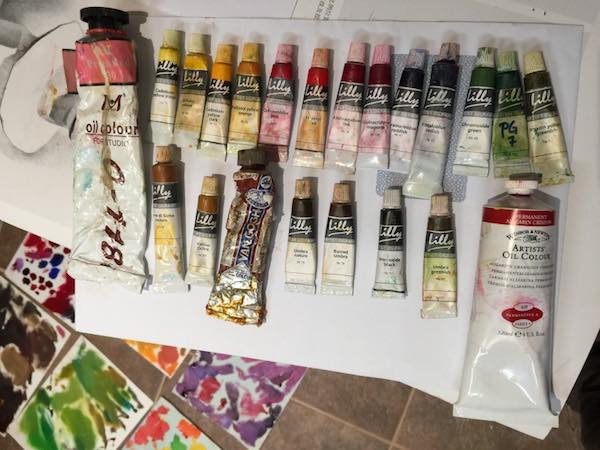I need a wide range of oil painting colors to get the color harmony I want in my work but it is always a problem carrying a lot of tubes of paint when you travel. This is even more of a problem when you travel by air.
With the help of a student of mine who has been making his own paints recently we’ve come up with some very interesting research that I think will be of great value to many painters. This palette will give you a lot of flexibility for the smallest number of tubes.
Pigments and paints

Pigments and paints are not the same thing. Paint is what you buy. A pigment is the stuff in the paint. It is either some natural mineral or a man-made substance.
Many colors do not just have one pigment. In fact most manufacturers’ paint ranges have a large number of colors that are created from a mixture of two and sometimes more different pigments.
However I have discovered that by using single pigment paints there are two key benefits:
- You can carry less paints with you when you travel, since you can easily mix many common colors from just two individual pigments.
- If you have separate pigments, you can mix a wider range of colors compared with paints that already have more than one pigment in them. This means a single-pigment palette will have a much wider gamut (range of colors you can mix).
The Gamut Optimized Single Pigment palette of oil painting colors
For this reason, I invented a new name for a palette that contains only single pigment colors and that lets you mix the widest possible range of colors: the Gamut Optimized Single Pigment Palette (GOSP palette). This is work in progress (started in 2016) and I am sure it will develop over the years. The phrase “Gamut Optimized” means that I have chosen specific pigments that:
- include pigments that give you colors you cannot get by any other means, and
- exclude pigments that can be mixed with a combination of other pigments.
I found that by mixing the following 15 pigments I could create every color I have ever had on my full spectrum palette. There was no color I could not exactly match with these oil painting colors by using some combination of these pigments.
Notes:
- The information given includes the Color Index Number of the pigment, and the Munsell color notation for the color your get for the pure pigment and when you mix the pigment with white. The three numbers in parenthesea are: no tint; 50% tint with Titanium White; and 90% tint with Titanium White.
- The hue shifts a little when you add white. In some cases it changes quite a lot, such as with Paliotol Yellow Orange PO59. Hue is the first number/letter in the Munsell notation.
- The value will increase by adding white. Hue is the second number in the Munsell notation.
- The saturation drops by adding white. Saturation is the third number in the Munsell notation.
Oil painting colors used in the palette
Black and White
- Titanium White PW6
- Iron Oxide Black, Mars Black PBk11
Yellows
- Cadmium Lemon/Yellow Light PY35 (7.75Y-9-12, 8.5Y-9-12 9.75Y-9-6)
- Cadmium Yellow Dark PY37 (3.5YR-6-14, 3.75YR-7-14,9.5YR-8-10)
Reds
- Napthol Red PR112 (8R-5-14, 7.75R-5-14, 6R-7-10)
- Quinacridone Pink PV19 (9.25R-3-12, 2R-4-12, 7R-6-8)
- Permanent Alizarin Crimson/Anthraquinone Red PR177 (7R-2-6, 6R-4-12, 9RP-6-10)
- Quinacridone Magenta PR122 (9.75R-1-6, 6RP-3-10, 2RP-6-10)
Blues
- Ultramarine Blue Reddish PB29 (7PB-2-12, 6.25PB-5-10, 5.25PB-8-4)
- Phthalo Blue Reddish PB15.1 (6.5PB2-10, 6PB-3-6, 2.75PB-5-4)
Note: It is critical you have the reddish version of both these pigments. The greenish versions will not let you mix a neutral blue.
Greens
- Phthalo Green PG7 (10G-1-4, 6BG-5-6, 1.5BG-7-6)
- Irgazin Yellow Greenish PY129 (2.5Y-1-2, 6.25Y-5-8, 7.75Y-9-8)
Earths
- Yellow Ochre PY42 (4.25YR-4-6, 6YR-6-6, 7.25YR-8-4)
- Raw Sienna PY43 (4.5YR-3-6, 7.5YR-6-2, 3.75YR-8-2)
- Transparent Oxide Red PR101 (10R-1-2, 8.25R-4-8, 9.25R7-6)
Experimenting with oil painting colors
A great way to experiment with this palette is to do a series of small color studies called Color Maps. Play around and see how many harmonies you can get.
For more information, see Oil Paints For Beginners and the Guide For How To Choose Oil Colors